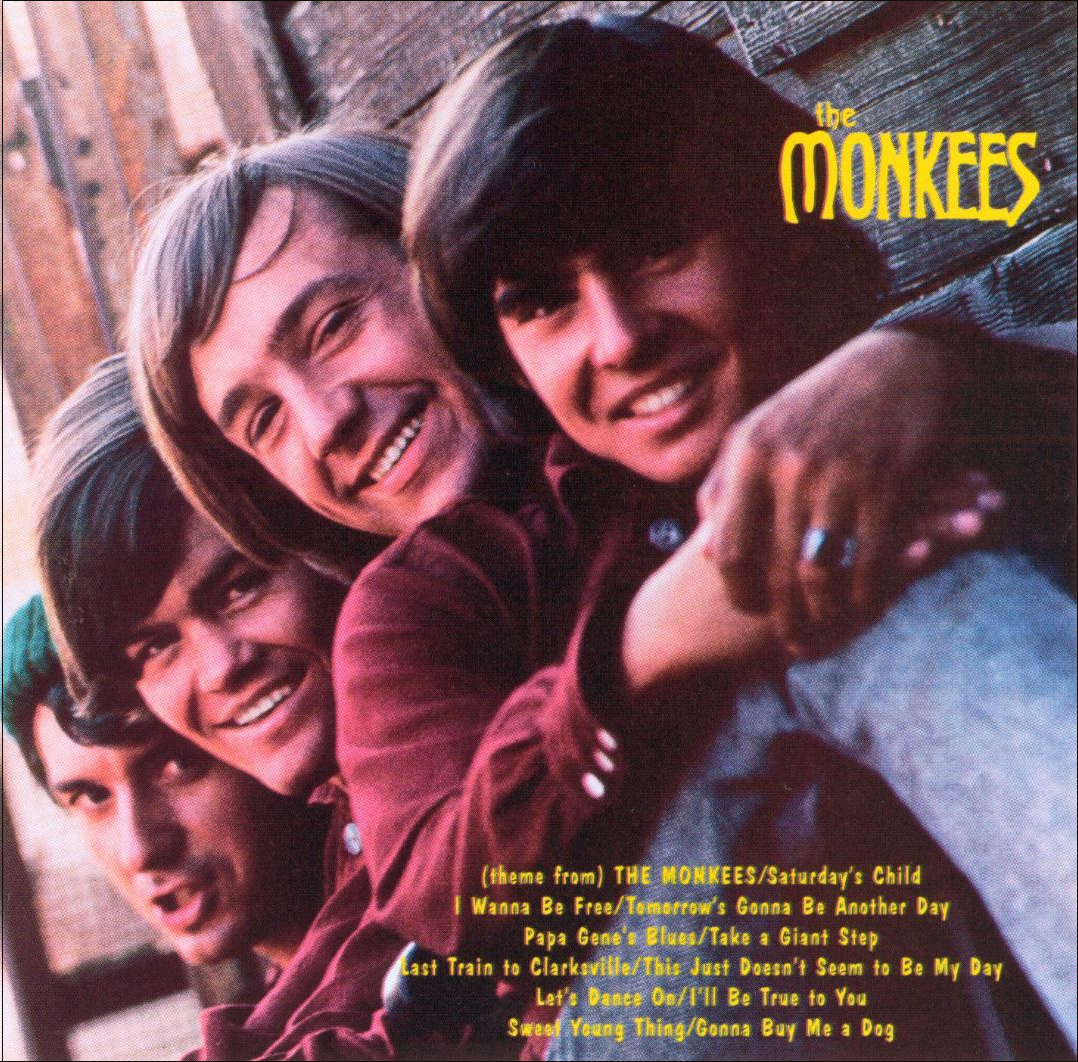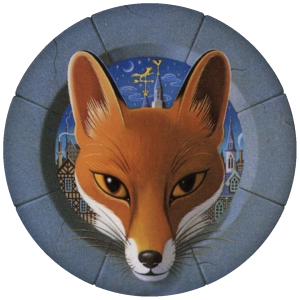
The Monkees, 1966
Produzent/ Tommy Boyce, Bobby Hart, Jack Keller, Michael Nesmith
Label/ Colgems
Das Debütalbum der Monkees war in gewisser Weise eines der revolutionärsten Alben von 1966. Nicht weil die Musik so innovativ gewesen wäre, die ist eher ein Abklatsch des British Pop, sondern weil hier erstmals Popmusik „crossmedial“ genutzt wurde. Die Monkees waren eine nach Aussehen und nicht nach Fähigkeiten gecastete Band zu einer Comedy-Serie und das Album der Soundtrack dazu.
Auch die Beatles hatten zuvor Filme gemacht, aber sie hatten die Musik diesen Filmen angepasst, waren da selber als Songwriter tätig gewesen. In den Staaten wollte der Produzent und Manager Don Kirshner an den Erfolg der beiden Beatles-Filme „A Hard day’s Night“ und „Help“anknüpfen, indem er eine Band castete, die lustige, verrückte Abenteuer auf ihrem Weg zum Ruhm erlebt. Dass die Protagonisten dabei Instrumente spielen können, war eher zweitrangig. Für das Album zur Serie holte sich Kirshner mit Tommy Boyce und Bobby Hart zwei professionelle Songwriter und hatte wohl auch vor, das Album von diversen Studiomusiker einspielen zu lassen – aber mit Micky Dolenz, Peter Tork und vor allem dem jungen Michael Nesmith waren bei der Fantasie-Band doch drei Personen dabei, die auch gerne selber musizieren wollten.
Tatsächlich wurde die „Band“ ins Studio geschickt, um zu „proben“ – damit sie im TV besser aussahen, aber dann schrieb Nesmith mit „Papa Gene’s Blues“ sogar einen eigenen Song, der sich vom Beat der anderen Stücke durch Country-Einflüsse unterschied. Und der Titelsong „(Theme from) The Monkees“ sowie „Last Train To Clarksville“ sind auch gelungene Songs, die Vocals sind purer Pop, die Stimme von Dolenz hat ein beachtliches Kapital. Aber insbesondere Nesmith – der einzige wirklich ernstzunehmende Musiker, der bald mit seiner First National Band zum Country-Rock wechseln sollte – hatte für die Monkees später nur Spott übrig. Seiner Meinung nach war die TV-Serie eine flache Comedy-Show mit vier Typen, die eine Band imitierten. Und der Spott galt natürlich auch diesem Album – was aus der Sicht eines Musikers nachvollziehbar ist.
Aber immerhin: die Monkees waren unterhaltsam und im Vergleich zu etlichen Casting Bands heutiger Zeit ist das Album goldenes Handwerk. Die Serie und die ersten beiden Alben hatten in den USA grossen Erfolg. Die Monkees gelten zu Recht als die erste zur kommerziellen Ausbeutung zusammengecastete Boyband – die aber allein schon deshalb interessant ist, weil sie sich in kurzer Zeit tatsächlich zu einer echten Band entwickelt hat.

Fällt mir doch sofort die Partridge Family ein – ähnliches Schicksal, mit anschließender David Cassidy Karriere.
Stimmt! Wie bereits bei den Monkees wurden später auch bei der Partridge Family parallel zur Serie Plattenalben mit der Musik der Sitcom-Popgruppe veröffentlicht. Ich selbst habe den Kult um die Partridge Family und den Star David Cassidy nie leiden können. Für mich keine Musik der Kategorie „Forever“. „Last Train To Clarksville“ und „I’m A Believer“ von den Monkees hingegen sind für mich zeitlose Beat-Schlager, Made in USA.
Partridge war halt MEINE Zeit. Die Serie fanden wir top. Musik von denen oder von Cassidy auf Band zu haben war allerdings – Buh! der rangierte unter Mädchenschwarm, Popo-Scheitel und Weich-Ei. Das legte sich erst mit seinen späten Songs „I write the songs“ und „last kiss“ ein bißchen. man wird ja älter. 🙂
Ja – was die Monkees in den Sechzigern waren, das sind Partridge Family in den Siebzigern gewesen: Popschund für den Teenagermarkt. Zu verstehen, wie das System funktioniert, hätte aber damals nur gestört. Menschen in Kostümen sollten anderen, einfältigeren Menschen gegen Bezahlung die Illusion vermitteln, dass das Leben knallbunt ist.
The Monkees in syndication inspired me to want to learn to play music. After the Monkees I found The Beatles and haven’t left. They inspired so many would be musicans to be in a band…and more than just one generation.
Interesting! In 1966 there was a lot of longhair-music here in the hitparade and the Monkees were well known, but not like the supergroups of the first hour like the Beatles, the Stones or the Beach Boys. The whole teenage hysteria around the Monkees was probably more confined to the US back then.
It was around 75 and I was 8 and watching the show in reruns. I had a cousin that knew I liked them and introduced me to „Meet The Beatles“ (the Capitol album) and I was lost… but I’ve always liked the Monkees…some good pop. They made it look fun to play music and to be in a band.
Mein Favorit ist immer Day Dream Believer.
Schön. Der Song wurde von John Stewart (Ex-Kingston Trio) geschrieben.
Genau. Danke.
Und schon hat mich wieder ein Ohrwurm im Griff: I’m a believer (und zwar die Fassung von den Monkees, nicht von Neil Diamond).
Sehr schön. „ I’m A Believer“ war ja die zweite Monkees-Single nach „Last Train To Clarksville“. Damals haben wir noch unsere Tonträger gegenseitig auf Kassetten überspielt.
Good for you for writing about the Monkees. I did one song by them on my blog but I have had a larger post in mind for some time. A lot of people would say they were a fake band and they can’t believe that a serious music blogger like you would write about them. (Or let’s say I would attract those people.) I always liked these guys and had a number of their records for a while. Their songs were catchy and highly melodic. I would argue that Peter Tork was also a serious musician. My guess is you know Stephen Stills auditioned. For the benefit of his credibility, it’s probably just as well he did not get accepted.
The Monkees showed that music calculated by a system doesn‘ t necessairly has to be flat and stale, and that even pop puppets can still have hints of brilliance. Of course the Monkees had a lot of Beatles riffs and melodies in their songs. But „I’m A Believer“ or „Last Train To Clarksville“ are somehow awesome, even if you hear some studio musicians like Glen Campell or Billy Preston on it. I think, the whole hysteria around the Monkees had a lot to do with the 60’s teenage market in the US. Stephen Stills was later glad, that he didn’t became a monkee.
Yes, thanks in large measure to the baby boom cohort (76 million born between 1946 and 1964) there were so many teenagers around by 1966 that they could not help but be a force. Continued, with of course a smaller number, to this day. The first record I even bought? „I’m a Believer.“
I still like „I’m A Believer“ from the Monkees (better than the original from Neil Diamond). It’s such a thing with the first record in life, similar to the first schoolday or the first kiss – things you’ll not forget. My first record was „I Feel Fine“ from the Beatles.